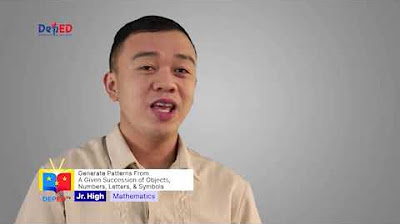Grade 10 Math Q1 Ep1: Generate Patterns from a Succession of Objects, Numbers, Letters & Symbols
Summary
TLDRIn this episode of 'DebaTV,' Teacher Jay guides students through an engaging lesson on logical reasoning and critical thinking, focusing on patterns and sequences. The video covers key concepts such as inductive reasoning, the process of observing data, and generating patterns from objects, numbers, letters, and symbols. Students learn about finite and infinite sequences, general terms, and how to solve problems related to patterns using step-by-step activities. The episode emphasizes that math is fun and easy, encouraging learners to actively participate and enjoy the learning process.
Takeaways
- 📚 The lesson focuses on enhancing logical reasoning and critical thinking skills through pattern recognition.
- 🔍 Inductive reasoning is defined as the process of observing data, recognizing patterns, and making generalizations or conjectures.
- 📈 A simple activity involving cutting strings is used to illustrate how the number of pieces relates to the number of cuts, leading to the formula y = x + 1 where y is the number of pieces and x is the number of cuts.
- 📝 The concept of sequences is introduced, explaining that a sequence is an ordered list where each element is called a term.
- 🔢 The difference between finite and infinite sequences is highlighted, with examples provided for clarity.
- 🔑 The general term of a sequence is explained, showing how it can be used to find specific terms in a sequence.
- 🧩 The process of finding the general term from given terms of a sequence is demonstrated, using patterns and algebraic manipulation.
- 🎓 The lesson includes interactive activities for learners to practice identifying patterns and applying the formula y = x + 1 to solve for the number of string pieces.
- 📉 The importance of recognizing patterns in sequences, such as the addition of a constant difference, is emphasized for solving sequence problems.
- 📊 A method for finding the general term of a sequence when given several terms is presented, involving identifying the pattern and formulating an algebraic expression.
Q & A
What is the main focus of today's episode of Debit TV?
-The main focus of today's episode is to help viewers develop their logical reasoning and critical thinking skills through the understanding and generation of patterns from a given succession of objects, numbers, letters, and symbols.
What is inductive reasoning as explained in the script?
-Inductive reasoning is the process of observing data, recognizing patterns, and making generalizations or conjectures from those observations. It is a method of reasoning from specific observations to a general conclusion or hypothesis.
What is the first activity that Teacher Jay introduces in the lesson?
-The first activity involves preparing five strings of equal length and then cutting them a varying number of times to observe the pattern in the number of pieces produced.
How many pieces of string are there after cutting the first string once?
-After cutting the first string once, there are two pieces.
What pattern does Teacher Jay ask the viewers to identify after cutting the strings?
-Teacher Jay asks the viewers to identify the pattern that the number of pieces (y) is one more than the number of cuts (x) made on the string.
What formula is used to represent the pattern found in the string-cutting activity?
-The pattern is represented by the formula y = x + 1, where y is the number of pieces and x is the number of cuts.
What is the definition of a sequence as mentioned in the script?
-A sequence is an order in which one thing follows another in succession, and it is an ordered list where each member or element is called a term.
What are the two classifications of sequences mentioned in the script?
-The two classifications of sequences are finite and infinite. Finite sequences have a limited number of terms and an end or last term, while infinite sequences have a countless number of terms without an end.
How is the general term of a sequence defined in the script?
-The general term of a sequence, also known as the nth term, is a formula that represents each term in the sequence and is usually denoted as a sub n, where n can be any integer from 1 to n.
What are the key steps to find the specified term or terms of a sequence when given the general term?
-The key steps include substituting the given value of n into the general term formula and performing the necessary operations to find the specified term.
What are the key steps to write the general term of a sequence when given some terms?
-The key steps involve identifying the pattern in the given terms, determining the relationship between consecutive terms, and formulating a general term that represents this relationship.
Outlines

Cette section est réservée aux utilisateurs payants. Améliorez votre compte pour accéder à cette section.
Améliorer maintenantMindmap

Cette section est réservée aux utilisateurs payants. Améliorez votre compte pour accéder à cette section.
Améliorer maintenantKeywords

Cette section est réservée aux utilisateurs payants. Améliorez votre compte pour accéder à cette section.
Améliorer maintenantHighlights

Cette section est réservée aux utilisateurs payants. Améliorez votre compte pour accéder à cette section.
Améliorer maintenantTranscripts

Cette section est réservée aux utilisateurs payants. Améliorez votre compte pour accéder à cette section.
Améliorer maintenantVoir Plus de Vidéos Connexes

Grade 10 Math Q1 Ep6: Geometric Sequence VS Arithmetic Sequence

Grade 10 Math Q1 Ep7: Finding the nTH term of a Geometric Sequence and Geometric Means

Grade 10 Math Q1 Ep4: Computing Arithmetic Means

Grade 10 Math Q1 Ep2: Generate Patterns From a Given Succession of Objects

Grade 10 MATH Q1 Ep3: Write and Use the Formula of the nth Term of an Arithmetic Sequences

📢 BARU BANGET Review Lengkap Psikotes PAMAPERSADA 2025 + JAWABAN
5.0 / 5 (0 votes)
